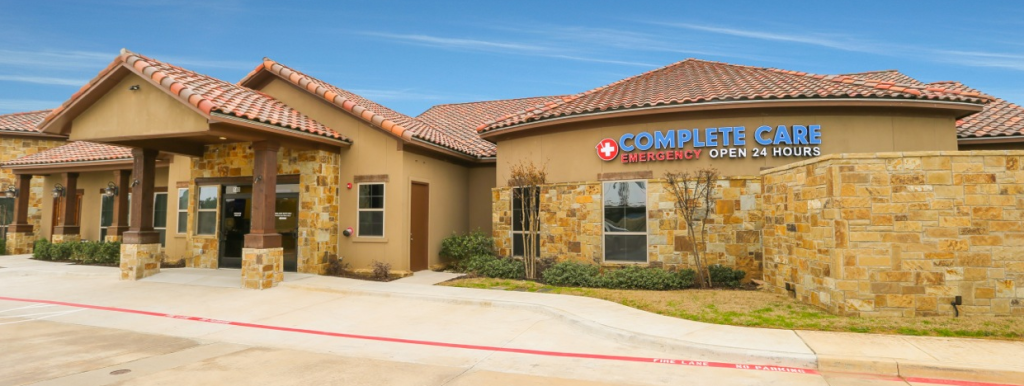Common Reasons for an ER Visit in 2025
Common Injuries
•
Sep 2, 2025
Reviewed by:

Life has a way of throwing unexpected curveballs our way, and sometimes those moments require an immediate ER visit. Whether it’s a sudden pain that won’t go away or an accident that catches you off guard, emergency rooms are there when you need them most. While every situation is unique, there are certain health concerns that bring people through our doors more often than others.
So, what is the most common reason for emergency room visits at Complete Care? Here are some of the top reasons patients have visited a Complete Care freestanding ER in 2025 (in no particular order):
- Infections and illnesses
- Abdominal pain
- Back or flank pain
- Allergic reactions
- Chest pain
- Burn care
- Injuries and trauma
If you find yourself in any of these situations, remember that Complete Care’s ER locations are here for you around the clock. Our compassionate team understands that medical emergencies can be frightening, and we’re committed to providing you and your family with the expert care and peace of mind you deserve.
For life-threatening situations, please call 911.
1. Infections and illnesses
From seasonal flu to urinary tract infections, infections and illnesses represent a significant portion of emergency room visit statistics. These conditions can escalate quickly, especially in vulnerable populations like young children, elderly individuals, or those with compromised immune systems. Common infections that bring patients to our doors include:
- Respiratory infections
- Skin infections
- Gastrointestinal bugs that cause severe dehydration
What makes infections particularly concerning is their unpredictable nature — a simple cold can develop into pneumonia, or a minor cut can lead to a serious bacterial infection. When you’re experiencing high fever, difficulty breathing, severe dehydration, or signs of sepsis, seeking immediate medical attention can prevent complications and ensure you receive the appropriate antibiotic treatment or supportive care your body needs.
2. Abdominal pain
Abdominal pain is consistently among the most common ER visits, and for good reason. The abdomen houses many vital organs, making it challenging to determine the cause of discomfort at home. From appendicitis and gallbladder issues to bowel obstructions and kidney stones, abdominal pain can signal anything from a minor digestive upset to a life-threatening emergency that requires immediate surgical intervention.
What’s particularly tricky about abdominal complaints is that left side belly pain might indicate completely different issues than right-sided pain, and the intensity doesn’t always correlate with severity. A dull ache could be a sign of a serious condition, while sharp pain might be relatively minor.
Our emergency medicine physicians are trained to quickly assess these symptoms, order appropriate imaging when necessary, and determine whether you need immediate treatment or can safely follow up with your primary care provider.
3. Back or flank pain
Back and flank pain can be absolutely debilitating, often striking without warning and making even simple movements unbearable. While many people assume back pain is just a muscle strain, it can actually indicate serious conditions like kidney stones, spinal infections, or even heart problems that radiate to the back. Flank pain, specifically, often points to kidney-related issues that may require immediate attention to prevent permanent damage.
The challenge with back pain is distinguishing between mechanical issues that might improve with rest and serious medical conditions that need prompt treatment. When back pain is accompanied by any of the following, it’s often one of the more valid reasons to go to the emergency room:
- Fever
- Numbness
- Difficulty urinating
- Severe pain that doesn’t improve with position changes
Our team can quickly assess whether your pain requires imaging, pain management, or urgent intervention.
4. Allergic reactions
Allergic reactions can range from mild skin irritation to life-threatening anaphylaxis, making them unpredictable and potentially dangerous. Food allergies, medication reactions, and environmental triggers can cause symptoms that escalate rapidly, sometimes within minutes. What starts as mild itching or a small rash can quickly progress to difficulty breathing, swelling of the face and throat, and dangerous drops in blood pressure.
The key with allergic reactions is recognizing when symptoms are progressing beyond what can be managed at home with antihistamines. If you experience the following symptoms, seek medical care immediately:
- Difficulty breathing
- Widespread hives
- Severe swelling
- Dizziness
- Rapid pulse
Our emergency teams are equipped with epinephrine, steroids, and other medications needed to reverse severe allergic reactions and prevent them from becoming life-threatening situations.
5. Chest pain
Chest pain strikes fear into most people’s hearts, and rightfully so — it can indicate everything from a heart attack to a pulmonary embolism. However, not all chest pain is heart-related; it can also stem from acid reflux, muscle strain, anxiety, or lung conditions. The challenge lies in determining which chest pain requires immediate attention and which can wait for a scheduled doctor’s appointment.
What makes chest pain evaluation so critical is that heart attacks and other serious conditions don’t always present with the classic “elephant on the chest” sensation we see in movies. When chest pain is accompanied by any of the following symptoms, it’s essential to seek emergency care immediately for proper cardiac evaluation and treatment:
- Shortness of breath
- Sweating
- Nausea
- Pain radiating to the arm or jaw
Women, elderly patients, and diabetics may experience subtle symptoms like nausea, jaw pain, or unusual fatigue. If you’re at all concerned about chest pain or heart health, it’s better to err on the side of caution and seek treatment immediately.
6. Burn care
Burns are more complex than many people realize, and proper burn care can mean the difference between a good healing outcome and permanent scarring or complications. While minor burns can often be treated at home, moderate to severe burns require specialized medical attention to prevent infection, assess depth, and determine the best treatment approach. Chemical burns, electrical burns, and burns covering large areas of the body always warrant emergency evaluation.
The first few hours after a burn injury are crucial for optimal healing and pain management. Emergency care providers can assess whether a burn requires specialized wound care, determine if you need a tetanus shot, and provide prescription pain management that’s often necessary for proper healing. Additionally, we can identify burns that may need referral to specialized burn centers and ensure you receive appropriate follow-up care instructions.
7. Injuries and trauma
Accidents happen when we least expect them, and injuries from falls, car accidents, sports, or workplace incidents can range from minor cuts to life-threatening trauma. What makes injury assessment challenging is that adrenaline can mask pain and symptoms, making it difficult to gauge the true extent of damage immediately after an incident. Head injuries, in particular, can have delayed symptoms that don’t appear until hours later.
Even seemingly minor injuries can have serious complications if not properly evaluated and treated. A “simple” fall might result in a concussion, internal bleeding, or fractures that aren’t immediately obvious. Deep cuts may require specialized suturing techniques to minimize scarring, and seemingly stable injuries might indicate internal damage that needs digital imaging to detect. Our trauma-trained staff can quickly assess your injuries, order appropriate tests, and ensure you receive the comprehensive care needed for optimal recovery.
Know when to go to the ER
While it’s natural to wonder whether your symptoms warrant emergency care, certain warning signs should never be ignored. Here are clear indicators that you should head to the emergency room immediately:
- Difficulty breathing or shortness of breath
- Chest pain or pressure, especially with sweating or nausea
- Severe abdominal pain that doesn’t improve
- Signs of stroke: sudden weakness, confusion, difficulty speaking, or facial drooping
- High fever with stiff neck or severe headache
- Severe allergic reactions with swelling or breathing problems
- Heavy bleeding that won’t stop
- Signs of severe dehydration, especially in children or elderly
- Head injuries with vomiting, confusion, or loss of consciousness
- Severe burns or burns from chemicals or electricity
- Broken bones with visible deformity or numbness
Remember, emergency rooms are designed to handle urgent medical situations, and our medical teams would much rather see you for a concern that turns out to be minor than have you delay care for something serious. If something feels wrong, it’s always better to err on the side of caution and seek medical attention.
24-hour emergency room services in Colorado Springs and Texas
Complete Care understands that health concerns don’t follow a 9-to-5 schedule, which is why our freestanding emergency rooms are open 24 hours a day, 365 days a year. No matter where you are in our service areas, Complete Care has convenient locations throughout Austin, Corpus Christi, Dallas/Fort Worth, East Texas, Lubbock, San Antonio, or Colorado Springs, ensuring that quality emergency services are accessible when you need them most.
Whether your ER visits are for routine care or serious medical emergencies, Complete Care is committed to being your trusted healthcare partner. Our freestanding ERs offer the same level of care as hospital emergency departments but often with shorter wait times and a more comfortable environment for you and your family, providing compassionate, expert medical care exactly when and where you need it.
More Helpful Articles by Complete Care:
- Signs of Dehydration in Kids: When to Bring Them to the ER
- Is There a Measles Outbreak in Texas?
- What Does Your Stomach Pain Location Mean?
- Signs of Diverticulitis
- Your Guide to Burn Blister Care
